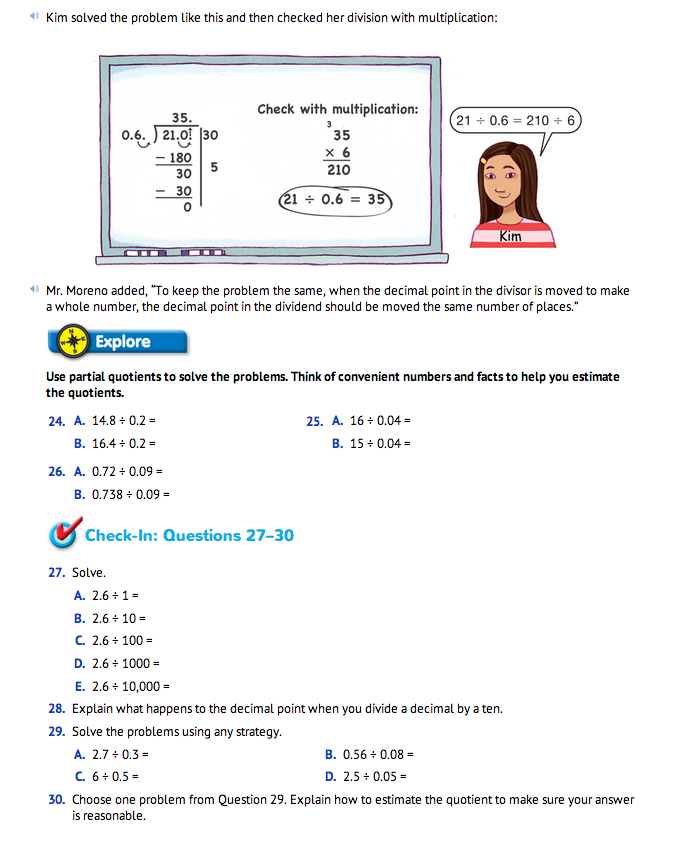Place the Decimal. Display the digits 60325.
- Here are the digits in a quotient, but the decimal point is missing.
- Estimate the quotient for 2413 ÷ 40. Where would you place the decimal within the digits I have displayed to make the correct quotient? How did you decide? (60.325; Possible response: The dividend 2413 is divided by a ten, so the quotient will be less than the dividend. I thought about multiplication and 4 × 6 = 24. 40 × 60 = 2400.)
- Estimate the quotient for 24.13 ÷ 4. What is the correct quotient and how did you decide? (6.0325; Possible response: If I just look at the whole numbers, I know 24 ÷ 4 is 6.)
- Estimate the quotient for 2.413 ÷ 0.4. What is the correct quotient and how did you decide? (It's also 6.0325; Possible response: 0.4 is less than 1, so the quotient is going to be more than the dividend, 2.413. 0.4 is a little less than half, so I thought “How many halves in 2?” It's 4, so 6.0325 is the closest quotient.)
- Estimate the quotient for 24.13 ÷ 0.4 and explain how you decided on the correct quotient. (60.325; Possible response: I thought about 24 base-ten flats and of how many sets of four-tenths go into 24. There are more than 2 sets of four-tenths per flat, so it will be at least 48. 60.325 seems reasonable.)
- Estimate the quotient for 24.13 ÷ 0.04 and explain how you decided on the correct quotient. (603.25; Possible response: I thought about the previous problem, 24.13 ÷ 0.4. I knew the divisor 0.04 was ten times smaller than 0.4, so the quotient will be 10 times larger than 60.325.)
Conclude the discussion by asking students to think about what they know about decimal operations.
- Compare the procedures for adding and subtracting decimals to the procedures for multiplying and dividing decimals.
Part of the discussion should include that to add and subtract decimals, you need to add or subtract like places by lining up the decimals. However, to multiply and divide decimals it is not necessary to line up the decimals in the problem. The computations can be done as if all numbers were whole numbers. The decimal point can be placed in the product or quotient after the calculations are complete.
Complete Decimal Quiz. Assign the Decimal Quiz Assessment Master for students to complete individually. Have base-ten pieces, fraction circle pieces, and copies of the Tenths Grids, Hundredths Grids, and Hundredths Circles Masters available. Students may refer to their My Decimal Strategies Menus from Lesson 8, and any pages in the Student Guide Reference section they find helpful as they complete the quiz.
Assign the Dividing Decimals pages in the Student Activity Book as homework after Part 2 to provide more practice with using strategies to divide decimals.
Use the Decimal Quiz Assessment Master with the Feedback Box to assess students' abilities to represent numbers to the thousandths [E1]; compare and order decimals to the thousandths [E3]; round decimals using place value understanding [E4]; add and subtract decimals to the thousandths using models and strategies [E7]; multiply and divide decimals using models and strategies [E8]; estimate decimal products and quotients [E9]; and find a strategy [MPE2].














